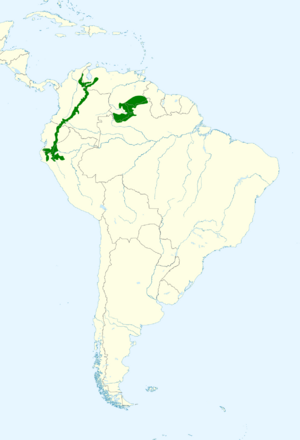Grey-chinned hermit facts for kids
Quick facts for kids Grey-chinned hermit |
|
|---|---|
 |
|
| Conservation status | |
| Scientific classification | |
| Genus: |
Phaethornis
|
| Species: |
griseogularis
|
 |
|
| Synonyms | |
|
|
The grey-chinned hermit (Phaethornis griseogularis) is a small, fast-flying hummingbird. It belongs to the Trochilidae family, which includes all hummingbirds. You can find this bird in several South American countries, including Brazil, Colombia, Ecuador, Peru, and Venezuela.
Contents
About the Grey-Chinned Hermit
How Scientists Classify Them
Scientists group living things into categories, and this is called taxonomy. For the grey-chinned hermit, most bird experts, like the International Ornithological Committee (IOC), agree there are three main types, or subspecies:
- P. g. griseogularis (the main type)
- P. g. zonura
- P. g. porcullae
However, one group, BirdLife International, thinks that P. g. porcullae is different enough to be its own separate species, which they call the "porculla hermit."
What They Look Like
The grey-chinned hermit is a small bird. The main two subspecies, P. g. griseogularis and P. g. zonura, are about 8 to 10 cm (3 to 4 inches) long. Males usually weigh between 1.8 to 2.5 grams, and females are a bit heavier, from 1.9 to 3 grams. To give you an idea, that's less than the weight of a penny!
The P. g. porcullae subspecies is slightly larger, about 10.5 cm (4 inches) long, and weighs around 2.5 grams. It also has longer wings.
All three types of grey-chinned hermits share some common features:
- Their upper bodies are mostly greenish.
- They have a reddish-brown area on their lower back, called the rump.
- Their tail feathers are dark with white tips.
Males have a grayish throat and reddish-brown underparts. They often have a black band across their chest. The P. g. zonura male is lighter in color than the main type, with more grayish underparts and a bill that curves down more. The P. g. porcullae is even paler than the other two and has more white in its tail. Female grey-chinned hermits look similar to the males but are usually lighter in color.
Where They Live
Each subspecies of the grey-chinned hermit lives in slightly different areas:
- P. g. griseogularis is found in the eastern Andes mountains. This includes parts of Colombia, Ecuador, northern Peru, southern Venezuela, and some mountains in northern Brazil. Sometimes, they are also seen in the western Andes of Colombia.
- P. g. zonura lives in the Marañón River valley in northern Peru.
- P. g. porcullae is found in the western Andes, from southwestern Ecuador into northern Peru.
These hummingbirds like places with lots of dense plants. This can be the lower parts of cloudforests, new forests growing back (secondary forest), or the edges of forests. The P. g. griseogularis also likes "gallery forests," which are forests that grow along rivers.
They usually live at elevations between 600 and 1800 meters (about 2,000 to 6,000 feet) above sea level. However, they can be found lower or higher depending on the region. For example, in eastern Colombia, they might be below 400 meters, and in Peru, as high as 2200 meters.
P. g. zonura prefers drier woodlands, while P. g. porcullae likes humid woodlands and wet spots within forests that are otherwise dry for part of the year.
Grey-Chinned Hermit Behavior
Movement
These hummingbirds are believed to be "sedentary," which means they generally stay in one place and do not migrate long distances.
Feeding Habits
Like many other hermit hummingbirds, the grey-chinned hermit subspecies P. g. griseogularis and P. g. zonura are "trap-line" feeders. This means they visit a regular circuit of flowering plants to drink nectar, much like a mail carrier follows a route. They also eat small arthropods, which are tiny insects and spiders. Scientists believe P. g. porcullae likely feeds in a similar way.
Reproduction and Life Cycle
Grey-chinned hermits are known to gather at special spots called leks. At leks, males perform displays to attract females for mating.
The exact breeding times for all subspecies are not fully known. However, P. g. griseogularis breeds around October, P. g. zonura in March, and P. g. porcullae seems to breed from January to June.
Only one nest of P. g. porcullae has been described. It was shaped like a cup, made from moss, plant fibers, and other plant materials. It was cleverly hung from the underside of a long, drooping leaf. This nest held two eggs, and both of them hatched. Scientists assume the nests of the other two subspecies are similar.
Vocalization
The songs of P. g. griseogularis and P. g. zonura are high-pitched series of notes. They repeat these notes constantly without pauses. The song often sounds like several evenly spaced, slightly rising notes followed by a more complex, warbling sound, such as 'tsi ... tsee ... tseeé ... tseotsetsee.' Their call is a sharp, explosive 'tseek!' which they mostly make while flying.
The song of P. g. porcullae is structured similarly to the others, but its notes are described as purer and higher-pitched. Besides their songs and calls, these hummingbirds also make an audible wing whir or buzz when they fly.
Conservation Status
The IUCN (International Union for Conservation of Nature) assesses the conservation status of animals. They consider both the "grey-chinned" and "porculla" hermits (treating them as separate species, as per HBW taxonomy) to be of "Least Concern." This means they are not currently at high risk of extinction.
However, the exact number of these birds is not known, and their populations are believed to be decreasing. While the main subspecies, P. g. griseogularis, is thought to be quite common, the relatively small living area of P. g. zonura could become a concern in the future. P. g. porcullae is also described as "fairly common" but also has a limited range. Luckily, it lives in several protected areas, which helps its survival.


